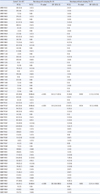1. Mignot E, Lin L, Rogers W, Honda Y, Qiu X, Lin X, et al. Complex HLA-DR and -DQ interactions confer risk of narcolepsy-cataplexy in three ethnic groups. Am J Hum Genet. 2001. 68:686–699.

2. Matsuki K, Honda Y, Juji T. Diagnostic criteria for narcolepsy and HLA-DR2 frequencies. Tissue Antigens. 1987. 30:155–160.

3. Juji T, Satake M, Honda Y, Doi Y. HLA antigens in Japanese patients with narcolepsy. All the patients were DR2 positive. Tissue Antigens. 1984. 24:316–319.
4. Mignot E, Lin X, Arrigoni J, Macaubas C, Olive F, Hallmayer J, et al. DQB1*0602 and DQA1*0102 (DQ1) are better markers than DR2 for narcolepsy in Caucasian and black Americans. Sleep. 1994. 17:8 Suppl. S60–S67.
5. Mignot E, Kimura A, Lattermann A, Lin X, Yasunaga S, Mueller-Eckhardt G, et al. Extensive HLA class II studies in 58 non-DRB1*15 (DR2) narcoleptic patients with cataplexy. Tissue Antigens. 1997. 49:329–341.
6. Mignot E, Hayduk R, Black J, Grumet FC, Guilleminault C. HLA DQB1*0602 is associated with cataplexy in 509 narcoleptic patients. Sleep. 1997. 20:1012–1020.
7. Rogers AE, Meehan J, Guilleminault C, Grumet FC, Mignot E. HLA DR15(DR2) and DQB1*0602 typing studies in 188 narcoleptic patients with cataplexy. Neurology. 1997. 48:1550–1556.
8. Hong SC, Lin L, Lo B, Jeong JH, Shin YK, Kim SY, et al. DQB1*0301 and DQB1*0601 modulate narcolepsy susceptibility in Koreans. Hum Immunol. 2007. 68:59–68.
9. Roh EY, Park MH, Park H, Park DH, Choi JB, Kim SJ, et al. Association of HLA-DR and -DQ genes with narcolepsy in Koreans: comparison with two control groups, randomly selected subjects and DRB1*1501-DQB1*0602--positive subjects. Hum Immunol. 2006. 67:749–755.
10. Park MH, Whang DH, Kang SJ. High resolution HLA-DQB1 typing by combination of PCR-RFLP and PCR-SSCP. Hum Immunol. 1999. 60:901–907.

11. Billiard M. Diagnosis of narcolepsy and idiopathic hypersomnia. An update based on the International classification of sleep disorders, 2nd edition. Sleep Med Rev. 2007. 11:377–388.

12. Lee KW, Oh DH, Lee C, Yang SY. Allelic and haplotypic diversity of HLA-A, -B, -C, -DRB1, and -DQB1 genes in the Korean population. Tissue Antigens. 2005. 65:437–447.

13. Lee KW, Jung YA, Oh DH. Diversity of HLA-DQA1 gene in the Korean population. Tissue Antigens. 2007. 69:Suppl 1. 82–84.

14. Voorter CE, van den Berg-Loonen EM. Sequence-based typing of the complete coding sequence of DQA1 and phenotype frequencies in the Dutch Caucasian population. Hum Immunol. 2006. 67:756–763.

15. Song EY, Park MH, Kang SJ, Park HJ, Kim BC, Tokunaga K, et al. HLA class II allele and haplotype frequencies in Koreans based on 107 families. Tissue Antigens. 2002. 59:475–486.

16. Voorter CE, Kik MC, van den Berg-Loonen EM. High-resolution HLA typing for the DQB1 gene by sequence-based typing. Tissue Antigens. 1998. 51:80–87.

17. Olerup O, Aldener A, Fogdell A. HLA-DQB1 and -DQA1 typing by PCR amplification with sequence-specific primers (PCR-SSP) in 2 hours. Tissue Antigens. 1993. 41:119–134.

18. Bunce M, Taylor CJ, Welsh KI. Rapid HLA-DQB typing by eight polymerase chain reaction amplifications with sequence-specific primers (PCR-SSP). Hum Immunol. 1993. 37:201–206.

19. Honda Y, Matsuki K. Thorpy M, editor. Genetic aspects of narcolepsy. Handbook of sleep disorders. 1990. New York: Marcel Dekker;217–234.
20. Dauvilliers Y, Bazin M, Ondzé B, Bera O, Besset A, Billiard M. Severity of narcolepsy among French of different ethnic origins (south of France and Martinique). Sleep. 2002. 25:50–55.

21. Neely S, Rosenberg R, Spire JP, Antel J, Arnason BG. HLA antigens in narcolepsy. Neurology. 1987. 37:1858–1860.

22. Watson NF, Ton TG, Koepsell TD, Gersuk VH, Longstreth WT Jr. Does narcolepsy symptom severity vary according to HLA-DQB1*0602 allele status? Sleep. 2010. 33:29–35.
23. Bassetti C, Aldrich MS. Narcolepsy. Neurol Clin. 1996. 14:545–571.

24. Hong SC, Lin L, Jeong JH, Shin YK, Han JH, Lee JH, et al. A study of the diagnostic utility of HLA typing, CSF hypocretin-1 measurements, and MSLT testing for the diagnosis of narcolepsy in 163 Korean patients with unexplained excessive daytime sleepiness. Sleep. 2006. 29:1429–1438.







 PDF
PDF ePub
ePub Citation
Citation Print
Print



 XML Download
XML Download